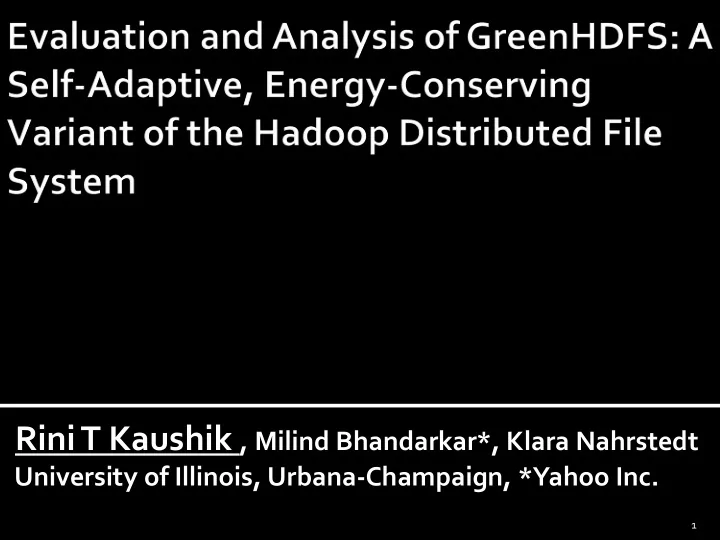

RiniT Kaushik , Milind Bhandarkar*, Klara Nahrstedt University of Illinois, Urbana-Champaign, *Yahoo Inc. 1
• Motivation 1 • Existing Techniques 2 • GreenHDFS 3 • Yahoo! Cluster Analysis 4 • Evaluation 5 2
Data-intensive Computing Rapidly Popular Advertising optimizations, Mail anti-spam, Data Analytics Growing Hadoop Deployment Open-source Hadoop platform of choice, Yahoo! 38000 servers , 170 PB Escalating Energy Costs Operating energy costs >= acquisition costs, Environmentally (Un)-friendly Energy-Conservation in Hadoop Clusters Necessary 3
• Scale-down Server • CPU (DVFS, DFS, DVS) & • Disks Cooling • Smart cooling Possible power states: Active, Idle, Inactive (Sleep) Idle Power = 30-40% Active Power Sleep Power = 3-10% Active Power Scale-down transitions servers from active to inactive (Sleep) power state most energy-proportional Scale-Down Very Attractive 4
Sufficient idleness • To mitigate power state transition time, energy expended No performance degradation Few power state transitions • To not reduce lifetime of disks 5
• Chase et. al., SOSP’01 Workload • G. Chen et. al., NSDI’08, ….. Migration • Con - Works if servers stateless Always-ON • Leverich et. al., HotPower’09 Covering • Amur et. Al., SOCC’10 Primary • Con - Write performance impact Replica Set 6
Data Data Data Data Data Hard to generate significant idleness Replicas and chunks distributed across cluster Workload migration not an option Servers NOT state-less Data-locality: Computations reside with data 7
Write Performance Important ▪ Reduce phase of Map-reduce task ▪ Production workloads such as click- stream processing operate on newly written data Need More Scale-Down Approaches in a Hadoop Cluster 8
Focus on energy-aware data placement instead of workload placement Exploit heterogeneity in data access patterns towards data-differentiated data placement Meets all scale-down mandates and works for Hadoop 9
Data Data Data Data Data Hot Zone Cold Zone Opportunities for consolidation: Scale-down (ZZZ….) 10-50% CPU Utilization * In peak loads: Compute capacity of Cold zone servers can be used * Barasso et. al. 10
• Minimize server wakeups • No data chunking • In-order file Hot Zone Cold Zone placement • On-demand power-on • Storage-heavy servers • Reduces cold zone’s Aggressive Performance footprint Energy-Driven -Driven Policies Policies Zones Trade-off Energy and Performance 11
File Migration Policy Dormant, low temperature data moved to Cold zone Run during low periods of load Coldness > Threshold FMP Hot Cold Zone Zone 12
Server Power Conservation Policy Server (CPU, DRAM & Memory) level Dormant > Threshold SCP Active Sleep Wake-on-LAN - File Access - Data Placement - Bit-Rot Scanning - File Deletion 13
File Reversal Policy Ensures QoS of data that becomes hot after period of dormancy Hot Cold Zone Zone Hotness > Threshold FRP 14
Maximize energy savings Minimize data oscillations Minimize performance degradation Can be achieved if none or few accesses to the Cold Zone 15
Low High Data Oscillations Hot Space File Migration Policy Performance Energy Savings Energy Performance Server Power Policy Savings State Changes Performance Data Oscillations File Reversal Policy 16
2600 servers, 5Petabytes, 34 millions files 1-month of HDFS traces and metadata snapshots Multi-tenant production cluster Analyzed 6 top-level directories each signifies a tenant ▪ Directories d, p, u, m 17
63.16% of total file count and 56.23% of total used capacity is cold (not accessed in 1-month) 18
First Last Create Delete Read Read Dormant • Create Lifespan LRD • Delete • Last Read Hot Lifespan CLR 19
90% of data’s first read happens within 2 days of creation 20
89% of data is accessed for less than 10 days after creation Threshold FMP should be > LifespanCLR 21
80% of data in dir d dormant for > 20 days 20% of data in dir p dormant for > 10 days 0.02% of data in dir m dormant beyond 1 day 22
89% of data in Yahoo! Hadoop compute cluster has a news-server-like access pattern Once data is deemed cold, low probability of it getting accessed again Significant idleness in Cold Zone high energy savings Few accesses to Cold Zone less performance degradation System stable – less data oscillations Great for GreenHDFS Goals 23
Trace-driven simulation driven by 1-month long hdfs traces from a 2600 server/ 5pb cluster for main directory dir d Hot zone 1170 Cold zone 390 Assumed 3-way replication in both zones Used power and transition penalties from datasheets of Quad Core Intel Xeon, Seagate Barracuda SATA disk * * not representative of Yahoo H/W Configuration 24
24% cost savings, $2.1 Million 38000 servers, in reality more savings (cooling, idle power in Hot zone) Minimally sensitive 25
Only 6.38TB worth of data migrated daily 26
Insignificant file reversals Data oscillations & energy savings insensitive to the File Migration Policy threshold. 27
More free space in Hot zone more hot data 28
Max power state transitions observed = 11, no risk to disk longevity 29
Results in significant energy cost reduction as shown with real-world large- scale traces from Yahoo! Hadoop Cluster Insensitive to thresholds Allows effective server-level scale-down in Hadoop Cluster ▪ Generates significant idleness in Cold Zone ▪ Few power state transitions ▪ No write performance impact 30
Thank You 31
Recommend
More recommend